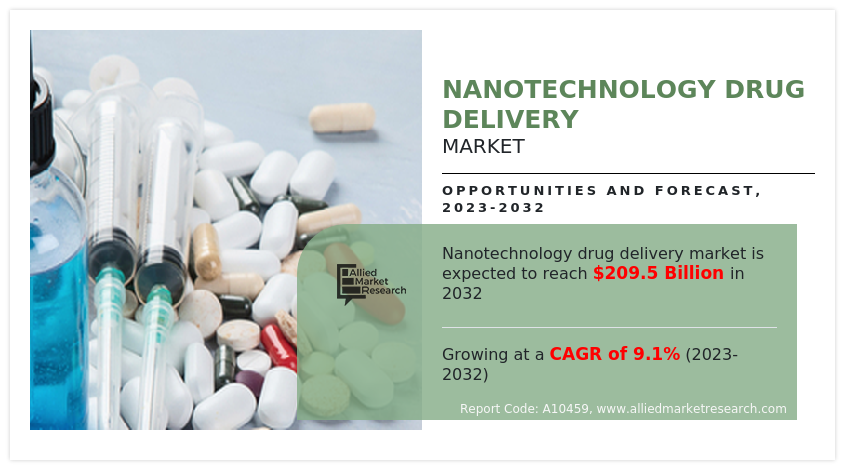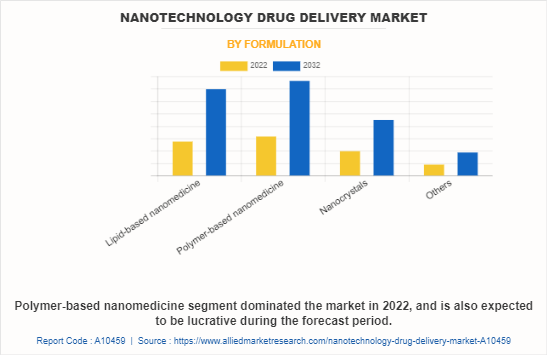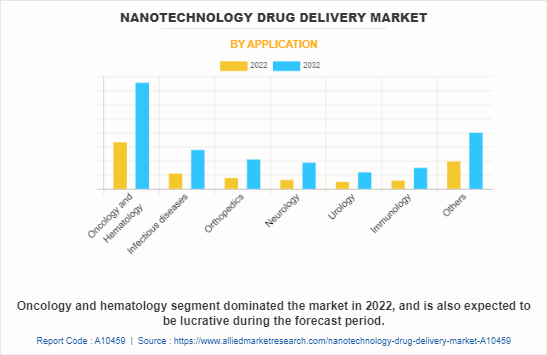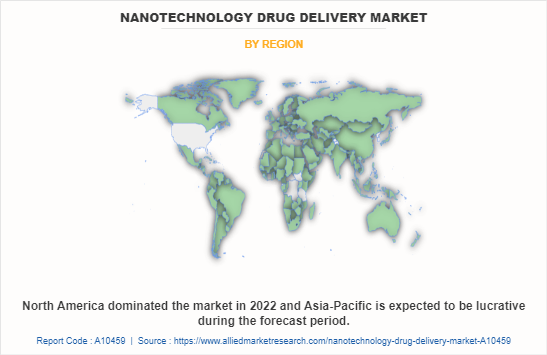Nanotechnology Drug Delivery Market Research, 2032
The global nanotechnology drug delivery market size was valued at $87.5 billion in 2022, and is projected to reach $209.5 billion by 2032, growing at a CAGR of 9.1% from 2023 to 2032. The nanotechnology drug delivery market refers to the application of nanotechnology in the development and delivery of therapeutic agents for the treatment of various diseases. Nanotechnology involves manipulating matter at the nanoscale, typically in the range of 1 to 100 nanometers, to create materials and structures with unique properties. Nanoscale drug delivery systems may enhance the solubility, stability, and bioavailability of drugs, as well as improve their targeting and release properties. Nanomedicines may be engineered to carry drugs to specific sites in the body, such as tumors or diseased tissues, while minimizing side effects and improving therapeutic outcomes.

Market dynamics
The nanotechnology drug delivery market share in expected to grow significantly, owing to prevalence of chronic diseases, such as cancer, cardiovascular disorders, diabetes, and neurological conditions, and technological advancement in the field of nanotechnology.
The prevalence of chronic diseases, including cancer, cardiovascular disorders, diabetes, and neurological conditions, has emerged as a major driver for the nanotechnology drug delivery market. These chronic diseases pose significant challenges to the healthcare industry due to their complex nature and long-term management requirements. According to American Cancer Society, it is estimated in 2023, about 297,790 new cases of invasive breast cancer will be diagnosed in women in U.S. Nanoparticles, nanocarriers, and other nanoscale drug delivery platforms offer unique properties that enhance drug stability, solubility, bioavailability, and control over release kinetics. For instance, In April 2022, researchers from the National University of Singapore, in collaboration with other institutions, demonstrated the potential of nano-sized vesicles released by red blood cells for delivering immunotherapeutic RNA molecules to suppress breast cancer and metastasis. Furthermore, Researchers at POSTECH, ' Pohang University of Science and Technology in South Korea, made an announcement on March 2, 2023, regarding their achievement in developing a nanomedicine method that enables electrical stimulation of the brain without requiring implanted electrodes. Their technique involves utilizing piezoelectric nanoparticles that react to ultrasonic waves, emitting nitric oxide and causing a temporary disruption of the blood-brain barrier. As a result, targeted delivery of therapeutic substances becomes possible. This non-invasive approach holds great potential for the treatment of brain diseases.
In addition, recent advancements in nanomaterials have opened new possibilities in the field of cardiovascular diseases (CVD) treatment. Significantly, the application of nanoparticles and nanocarriers in cardiology has attracted considerable attention due to their inherent characteristics, which include actively and passively targeting cardiac tissues, improved specificity for targets, and heightened sensitivity. A study report by the National Library of Medicines in 2023 revealed that nanotechnology may efficiently treat over 50% of CVDs. Employing nano carrier-based drug delivery specifically tailored for the heart is an effective and efficient approach to address cardiac-related disorders like atherosclerosis, hypertension, and myocardial infarction.
Furthermore, technological advancement in the field of nanotechnology has also contributed significantly to the growth of the market. For instance, researchers from Mount Sinai Health System and Memorial Sloan Kettering Cancer Center, U.S., announced the development of a drug delivery approach using nanoparticles to deliver anti-cancer drugs more effectively and target brain tumors in children. The delivery of drugs to specific tumor sites is enhanced, while simultaneously minimizing impact on healthy regions of the brain by utilizing this technology. As a result, the effectiveness of treatment is improved, and the occurrence of toxic side effects is reduced. In addition, in 2020, researchers from the University of Michigan, USA developed a synthetic protein nanoparticle capable of passing through the blood-brain barrier in mice. This nanoparticle holds the potential for delivering cancer-killing drugs directly to malignant brain tumors.
Moreover, microrobots in nanotechnology have gained significant attention in healthcare applications due to their potential for targeted drug delivery, minimally invasive surgery, and precise diagnostics. These tiny robots, often measuring less than a millimeter in size, are designed to navigate and interact with biological systems at the cellular or molecular level. For instance, in 2022, researchers at Daegu Gyeongbuk Institute of Science and Technology (DGIST) in South Korea developed a technology to produce over 100 microrobots per minute that may be disintegrated into the body. This advancement is expected to enhance regenerative medicine, including stem cell delivery.
However, the manufacturing complexities such as maintaining stability while large scale production of nanomedicines is expected to act as a significant restraint for the nanotechnology drug delivery. The production of nanoscale drug delivery systems requires precise control over various parameters, including particle size, shape, surface characteristics, and drug loading capacity. Achieving these specifications consistently and on a large scale may be extremely challenging. Nanoparticles are typically synthesized using complex techniques such as emulsion, precipitation, and self-assembly, which demand meticulous control over reaction conditions, solvent selection, and surface modification
On the other hand, increase in Government initiatives such as funding to establish research centers for research and development of nanotechnology have the potential to act as significant growth opportunities in the field of nanotechnology drug delivery. For instance, The National Nanotechnology Initiative (NNI) is a U.S. Government research and development (R&D) initiative. The NNI participating agencies work together to advance discovery and innovation across nanotechnology R&D. Ministry of Electronics and Information Technology (MeitY) India, has taken several major initiatives for the promotion of Nanoelectronics research and innovation in the country. Major Nanoelectronics Centers of international standards have been established at premier institutes in the country.
The COVID-19 pandemic had a positive impact on the nanotechnology drug delivery market size. The pandemic has brought attention to the capabilities of nanotechnology in delivering drugs. The pressing requirement for effective COVID-19 treatments and vaccines has resulted in swift progress in the field of nanomedicine. Scientists have employed nanoparticles to deliver drugs, such as antivirals and antibodies, with the specific aim of targeting the SARS-CoV-2 virus. These tiny carriers have the ability to boost drug stability, extend drug release duration, and enhance the availability of therapeutic substances. A notable example is the mRNA-based COVID-19 vaccines developed by Pfizer-BioNTech and Moderna. However, in the post pandemic phase the resuming of research in other sectors of healthcare other than COVID-19 will further drive the nanotechnology drug delivery market growth.
Segmental Overview
The nanotechnology drug delivery market share is segmented on the basis of formulation, application, and region. By, On the basis of formulation, the market is categorized into lipid-based nanomedicine, polymer-based nanomedicine, nanocrystals, and others. The others include inorganic nanoparticles, protein-based nanoparticles, and micelles. On On the basis of application, the market is categorized into oncology & hematology, infectious diseases, orthopedics, neurology, urology, immunology, and others. The others include gastrointestinal, inflammatory, endocrine, integumentary ophthalmology, and cardiology. Region-wise On the basis of region, the market is analyzed across North America (the U.S., Canada, and Mexico), Europe (Germany, France, the UK, Italy, Spain, and Rest of Europe), Asia-Pacific (Japan, China, Australia, India, South Korea, and Rest of Asia-Pacific), and LAMEA (Brazil, South Africa, Saudi Arabia, and Rest of LAMEA).
By Formulation:
The nanotechnology drug delivery market is categorized into lipid-based nanomedicine, polymer-based nanomedicine, nanocrystals, and others. The others include inorganic nanoparticles, protein-based nanoparticles, and micelles. The polymer-based nanomedicine segment was the largest revenue contributor to the market in 2022, owing to high degree of versatility in terms of formulation design and drug delivery strategies. However, Lipid-based nanomedicine is expected to register fastest growth during the forecasted period. This is attributed to the fact lipids are natural compounds found in the human body and have excellent biocompatibility. Lipid based nanomedicines are non-toxic, biodegradable, and may mimic biological membranes.

By Application:
On the basis of application, nanotechnology drug delivery market is segmented into oncology & hematology, infectious diseases, orthopedics, neurology, urology, immunology, and others. The others include gastrointestinal, inflammatory, endocrine, integumentary, ophthalmology, and cardiology. The oncology & hematology segment was the highest revenue contributor to the market and is expected to remain dominant during the nanotechnology drug delivery market forecast period. This is attributed to the high research and development activities towards the application of nanotechnology to effectively treat cancer.

By Region:
On the basis of region, the nanotechnology drug delivery market is analyzed across North America, Europe, Asia-Pacific, and LAMEA. North America accounted for largest share in the market for nanotechnology drug delivery in 2022. This is attributed to advancements in technology in nanomedicines and rise in prevalence of chronic disease such as cancer and strong presence of nanotechnology drug delivery industry in this region. However, Asia-Pacific is expected to register a noteworthy CAGR during the forecast period, owing to favorable government initiatives such as funding and presence of high-tech research institutes.

Competition Analysis
Competitive analysis and profiles of the major players in the nanotechnology drug delivery market, such as Abbvie Inc, Pfizer Ltd, AstraZeneca plc, Johnson & Johnson, Amgen Inc, Merck KGaA, Nanobiotix SA, Novartis AG, Bristol-Myers Squibb Company, and Teva Pharmaceutical Industries Limited. Major nanotechnology drug delivery industry have adopted agreement, partnership, and collaboration as key developmental strategies to improve the product portfolio and gain strong foothold in the nanotechnology drug delivery market.
Recent Agreement in the nanotechnology drug delivery market
In January 2022, Pfizer Inc, global pharmaceutical company, announced the agreement with Acuitas Therapeutics, for the expansion of lipid nanoparticle (LNP) formulation technology. The lipid nanoparticle delivery system is used for mRNA vaccine and therapeutics.
Recent Partnership in the nanotechnology drug delivery market
In May 2021, Nanobiotix SA, late-stage clinical biotechnology company, announced a partnership with LianBio, a biotechnology company in China and major Asian markets. The partnership aims to develop and commercialize Nanobiotix lead product candidate NBTXR3, a potential first-in-class radioenhancer, in Greater China (mainland China, Hong Kong, Taiwan, and Macau), South Korea, Singapore, and Thailand.
Recent Collaboration in the nanotechnology drug delivery market
Furthermore, in January 2021, Nanobiotix SA, late-stage clinical biotechnology company, through its subsidiary Curadigm announced that it has entered into collaboration with Sanofi. The collaboration is focused on nano primer technology of Curadigm as a highly promising option to significantly improve gene therapy development.
Key Benefits For Stakeholders
- This report provides a quantitative analysis of the market segments, current trends, estimations, and dynamics of the nanotechnology drug delivery market analysis from 2022 to 2032 to identify the prevailing nanotechnology drug delivery market opportunity.
- The market research is offered along with information related to key drivers, restraints, and opportunities.
- Porter's five forces analysis highlights the potency of buyers and suppliers to enable stakeholders make profit-oriented business decisions and strengthen their supplier-buyer network.
- In-depth analysis of the nanotechnology drug delivery market segmentation assists to determine the prevailing market opportunities.
- Major countries in each region are mapped according to their revenue contribution to the global market.
- Market player positioning facilitates benchmarking and provides a clear understanding of the present position of the market players.
- The report includes the analysis of the regional as well as global nanotechnology drug delivery market trends, key players, market segments, application areas, and market growth strategies.
Nanotechnology Drug Delivery Market Report Highlights
| Aspects | Details |
| Market Size By 2032 | USD 209.5 billion |
| Growth Rate | CAGR of 9.1% |
| Forecast period | 2022 - 2032 |
| Report Pages | 245 |
| By Formulation |
|
| By Application |
|
| By Region |
|
| Key Market Players | AstraZeneca plc, Teva Pharmaceutical Industries Limited, Abbvie Inc, Johnson & Johnson, Novartis AG, Pfizer Ltd, Merck KGaA, Amgen Inc., Bristol-Myers Squibb Company, Nanobiotix SA |
Analyst Review
The field of nanotechnology has revolutionized the drug delivery market by offering innovative solutions for targeted and efficient drug administration. Nanotechnology involves the manipulation and control of materials at the nanoscale level, typically ranging from 1 to 100 nanometers. This technology has the potential to significantly improve the efficacy and safety of drug delivery systems. The strategies such as agreement and partnership adopted by key players are expected to drive the growth of the market.
In January 2022, Pfizer Inc, multinational pharmaceutical and biotechnology, announced the agreement with Acuitas Therapeutics, for the expansion of lipid nanoparticle (LNP) formulation technology. The lipid nanoparticle delivery system is used for mRNA vaccine and therapeutics.
In May 2021, Nanobiotix SA, late-stage clinical biotechnology company, announced a partnership with LianBio, a biotechnology company in China and major Asian markets. The partnership aims to develop and commercialize Nanobiotix lead product candidate NBTXR3, a potential first-in-class radio enhancer, in Greater China (mainland China, Hong Kong, Taiwan, and Macau), South Korea, Singapore and Thailand.
The top companies that hold the market share in nanotechnology drug delivery market are Abbvie Inc, Pfizer Ltd, AstraZeneca plc, Johnson & Johnson, Amgen Inc, Merck KGaA, Nanobiotix SA, Novartis AG, Bristol-Myers Squibb Company, and Teva Pharmaceutical Industries Limited
Asia-Pacific is anticipated to witness lucrative growth during the forecast period, owing to favorable government initiatives such as funding and presence of high-tech research institutes.
The key trends in the nanotechnology drug delivery market are due to rise in prevalence of chronic diseases, and advancement in nanotechnology.
The base year for the report is 2022.
North America is the largest regional market for nanotechnology drug delivery market
The total market value of nanotechnology drug delivery market market is $87.5 billion in 2022 .
The forecast period in the report is from 2023 to 2032
Major restraints in the nanotechnology drug delivery market are manufacturing complexities
Loading Table Of Content...
Loading Research Methodology...


